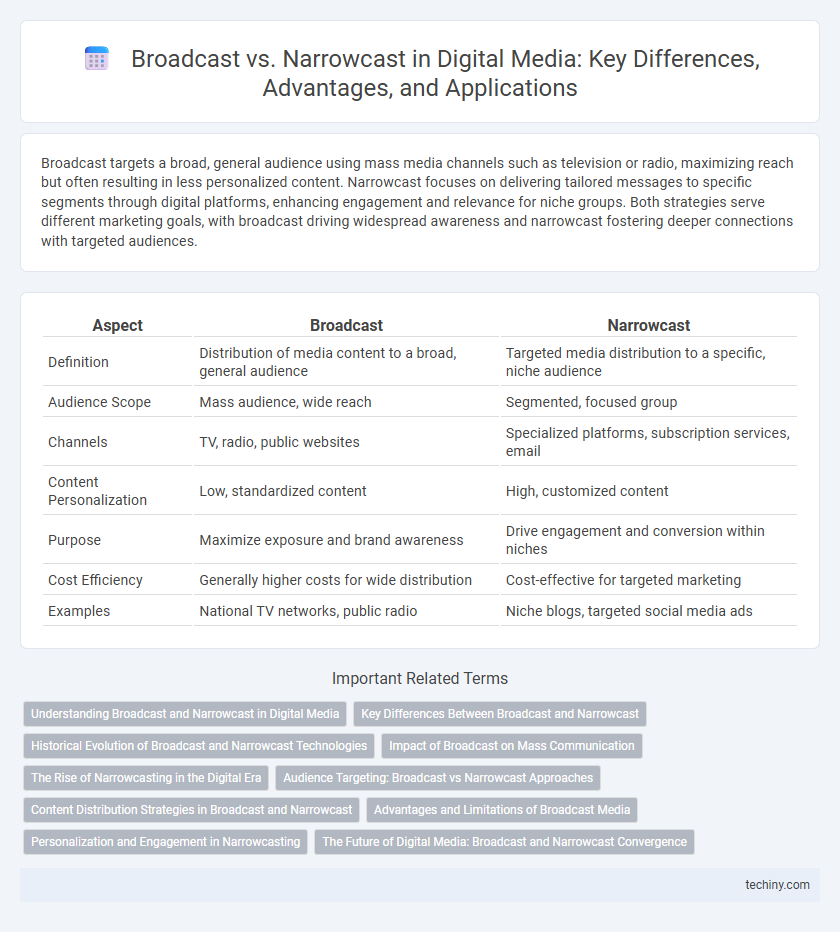Broadcast targets a broad, general audience using mass media channels such as television or radio, maximizing reach but often resulting in less personalized content. Narrowcast focuses on delivering tailored messages to specific segments through digital platforms, enhancing engagement and relevance for niche groups. Both strategies serve different marketing goals, with broadcast driving widespread awareness and narrowcast fostering deeper connections with targeted audiences.
Table of Comparison
| Aspect | Broadcast | Narrowcast |
|---|---|---|
| Definition | Distribution of media content to a broad, general audience | Targeted media distribution to a specific, niche audience |
| Audience Scope | Mass audience, wide reach | Segmented, focused group |
| Channels | TV, radio, public websites | Specialized platforms, subscription services, email |
| Content Personalization | Low, standardized content | High, customized content |
| Purpose | Maximize exposure and brand awareness | Drive engagement and conversion within niches |
| Cost Efficiency | Generally higher costs for wide distribution | Cost-effective for targeted marketing |
| Examples | National TV networks, public radio | Niche blogs, targeted social media ads |
Understanding Broadcast and Narrowcast in Digital Media
Broadcast in digital media refers to transmitting content to a broad, general audience through platforms like television, radio, and online streaming services, maximizing reach and exposure. Narrowcast targets specific segments or niches using personalized messages via email marketing, social media ads, or specialized streaming channels, increasing engagement and relevance. Understanding the distinct strategies of broadcast and narrowcast enables marketers to optimize content distribution for maximum impact and audience connection.
Key Differences Between Broadcast and Narrowcast
Broadcast involves transmitting digital media content to a wide, general audience over large geographic areas using platforms like television and radio, ensuring mass reach and high visibility. Narrowcast targets a specific, well-defined audience segment through specialized channels or online platforms, enabling personalized content delivery and higher engagement rates. Key differences include audience scope, content customization, and distribution methods, with broadcast favoring broad exposure and narrowcast optimizing relevance and interaction.
Historical Evolution of Broadcast and Narrowcast Technologies
Broadcast technology originated with radio transmissions in the early 20th century, evolving into television broadcasting that reached mass audiences through over-the-air signals. Narrowcast technology emerged later as cable and satellite systems enabled targeted content delivery to specific demographic groups or interest communities. The digital era accelerated this evolution with internet streaming and algorithm-driven platforms facilitating personalized narrowcasting alongside traditional broad broadcast models.
Impact of Broadcast on Mass Communication
Broadcast media delivers content to a broad, diverse audience, significantly amplifying the reach of mass communication by enabling simultaneous dissemination of information. This widespread delivery fosters shared cultural experiences and facilitates real-time updates during critical events, shaping public opinion and societal norms. The impact of broadcast media is evident in its ability to influence large-scale behavior and mobilize communities through accessible, widespread channels such as television, radio, and large digital platforms.
The Rise of Narrowcasting in the Digital Era
Narrowcasting has surged in the digital era, leveraging targeted content delivery to specific audience segments through platforms like social media, streaming services, and podcasts. Unlike traditional broadcasting that distributes uniform messages to broad audiences, narrowcasting utilizes data analytics and user profiles to customize media experiences, enhancing engagement and advertising efficiency. This shift allows brands to optimize marketing strategies by reaching niche markets with tailored messages, driving higher conversion rates and audience loyalty.
Audience Targeting: Broadcast vs Narrowcast Approaches
Broadcast media targets a broad, heterogeneous audience aiming for maximum reach and general appeal across diverse demographics. Narrowcast media utilizes data-driven strategies to deliver tailored content to specific, segmented audiences, enhancing engagement and conversion rates. Audience targeting in narrowcasting leverages advanced analytics and behavioral insights to optimize relevance, whereas broadcasting relies on uniform message distribution.
Content Distribution Strategies in Broadcast and Narrowcast
Broadcast content distribution strategies prioritize wide-reaching signals to deliver uniform programming to a mass audience, maximizing exposure across diverse demographics through television, radio, and public streaming platforms. Narrowcast strategies focus on targeted, segmented content delivery using algorithms, subscription models, and personalized channels to engage specific interest groups or niches with highly relevant media. This approach enhances audience engagement and retention by leveraging data analytics, enabling precise content customization within digital ecosystems.
Advantages and Limitations of Broadcast Media
Broadcast media reaches a wide, heterogeneous audience simultaneously, making it highly effective for mass marketing and public announcements. Its advantages include extensive coverage, immediate dissemination, and strong brand awareness generation, but limitations involve high costs, limited audience targeting precision, and potential message dilution. Broadcast channels such as television, radio, and digital streaming offer scalability but may struggle with engagement metrics compared to more personalized narrowcast approaches.
Personalization and Engagement in Narrowcasting
Narrowcasting leverages data-driven personalization to deliver highly targeted digital media content, enhancing user engagement by matching viewers' specific interests and preferences. Unlike broadcast, which disseminates uniform content to a broad audience, narrowcasting utilizes analytics and user profiles to tailor messages, resulting in increased relevance and higher interaction rates. This precise targeting fosters stronger audience loyalty and improved conversion metrics in digital media campaigns.
The Future of Digital Media: Broadcast and Narrowcast Convergence
The future of digital media signifies a convergence between broadcast and narrowcast technologies, leveraging the expansive reach of broadcast with the targeted precision of narrowcast. Emerging platforms utilize AI-driven algorithms and data analytics to deliver personalized content streams while maintaining mass accessibility, optimizing user engagement and advertiser ROI. This hybrid model enhances content distribution efficiency, driving innovation in multi-platform experiences and shaping next-generation audience interaction.
Broadcast vs Narrowcast Infographic

 techiny.com
techiny.com